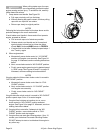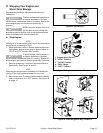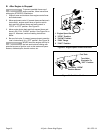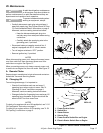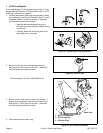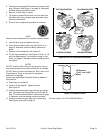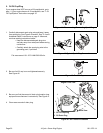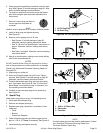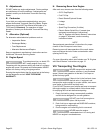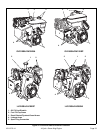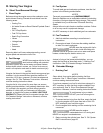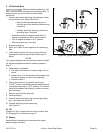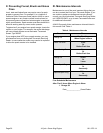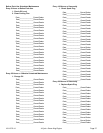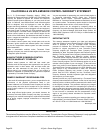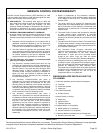
Page 22 4-Cycle • Snow King Engine 181-1275-14
D. Adjustments
DO NOT make any engine adjustments. Factory settings
are satisfactory for most conditions. If adjustments are
needed, contact your Authorized Tecumseh Servicing
Dealer.
E. Carburetor
If you think your carburetor needs adjusting, see your
nearest Authorized Tecumseh Servicing Dealer. Engine
performance should NOT be affected at altitudes up to
7,000 feet (2,134 meters). For operation at higher
elevations, contact your Authorized Tecumseh Servicing
Dealer.
F. Alternator (Optional)
For alternator related electrical problems such as:
• Inoperative Starter
• Discharged Battery
• Fuse Replacement
• Alternator Maintenance/Repairs
See your equipment manufacturer’s instructions and an
Authorized Tecumseh Servicing Dealer.
G. Engine Speed
To avoid serious injury or death, DO
NOT modify engine in any way.
Tampering with the governor setting can lead to a runaway
engine and cause it to operate at unsafe speeds. NEVER
tamper with factory setting of engine governor.
Running the engine faster than the speed set at the factory
can be dangerous and will VOID THE ENGINE
WARRANTY.
H. Removing Snow from Engine
After each use, remove snow from the following areas:
• Oil Fill Cap/Dipstick
• Fuel Fill Cap
• Recoil Starter/Flywheel Screen
• Linkage
•Guards
• Spark Plug Connection (If visible).
• Electric Starter Switch Box, if present (see
equipment manufacturer’s instructions).
See "A. Engines with Electric Starters" instructions
on page 10. Afterward, continue reading
instructions below.
NOTE
See equipment manufacturer’s instructions for proper
location of fuel fill cap and control lever.
Removing snow will ease operation of the recoil starter
rope and reduce the risk of water contamination when
opening fuel fill cap.
NOTE
For more information about recoil starters see "B. Engines
with Recoil Starters" instructions on page 13.
VIII. Transporting Your Engine
NEVER transport this engine inside
another vehicle or in any enclosed
space if there is any gasoline in the tank. Fuel vapor or
spilled fuel may ignite.
If there is fuel in the fuel tank, close
the fuel valve, if equipped, and
transport the engine upright in an open vehicle, such as an
open trailer or open bed of a pickup truck.
If you DO NOT have an open vehicle and have to transport
the engine upright in a closed vehicle, follow these steps
for emptying the fuel tank before transporting:
1. Empty fuel tank by using a commercially available
suction device designed for use with gasoline.
DO NOT pour fuel from engine or
siphon fuel by mouth.
2. Drain fuel into an approved red GASOLINE container,
being careful to avoid spilling.
3. Run the engine until remaining fuel is consumed.
NEVER leave the engine
unattended when it is running and
NEVER run engine in enclosed areas.
!
WARNING
!
WARNING
!
WARNING
!
WARNING
!
WARNING



